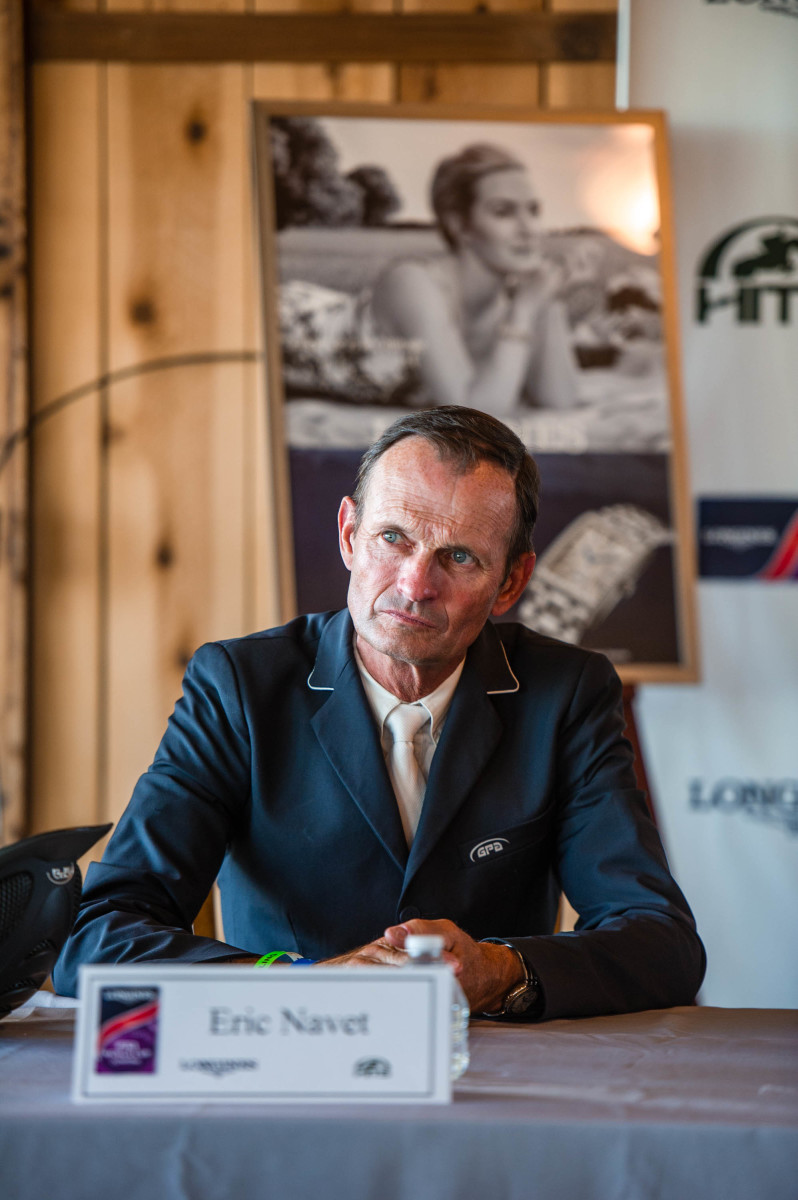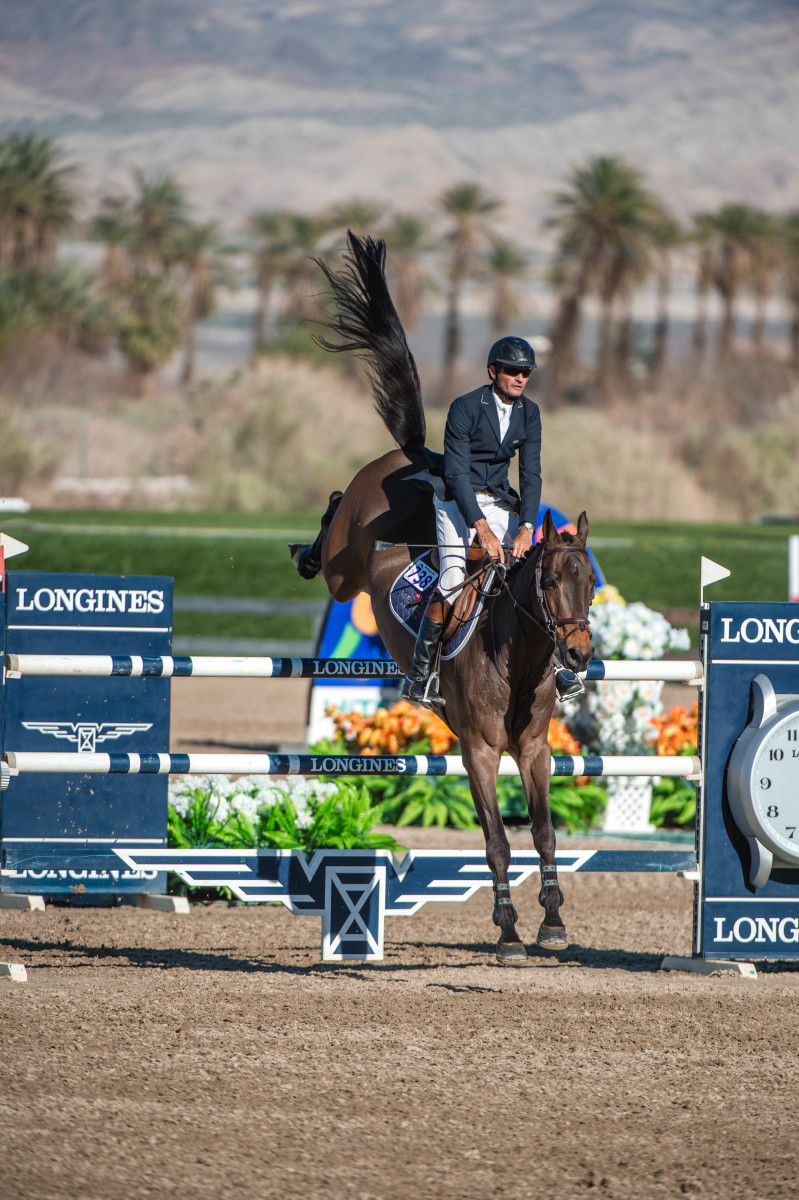French Olympian and 1990 World Equestrian Games champion Eric Navet grew up breaking young horses at his father’s farm, Haras De Baussy, in France, and taking them to their first competitions. His father, Alain, was a farmer, breeder and top-level rider who was named to France’s 1968 Olympic team, though an ankle injury from a foal’s kick precluded him from going.

In addition to learning everything about riding and horsemanship from his father and training up to 30 young horses each year, Eric, now 61, gained international attention in the Junior European Championships, where over three years he earned two silver medals as well as an individual gold.
Eric was selected to represent France at the 1984 Los Angeles Olympics after being partnered with J’t’adore just three months earlier. After that, he and his homebred Quito de Baussy enjoyed several years at the top of the sport. They earned
• Individual and team gold at the 1990 World Equestrian Games
• Team gold at the 1991 European Championships
• Team bronze at the 1992 Barcelona Olympics
• Team silver at the 1994 World Equestrian Games
Eric had international success with other horses as well, including a team silver medal at the 1998 World Equestrian Games with Atout d’Isigny as well as team gold and individual silver at the 2002 World Equestrian Games and an appearance at the 2004 Olympics with Dollar du Murier. Throughout his career, Eric has won five gold medals at the French national championships.
Eric moved to Rancho Santa Fe, California, in 2013 to be the personal coach for grand prix rider Karl Cook. Fast forward seven years and Eric and Karl are the collaborative crux of Pomponio Ranch, mixing old-fashioned horsemanship and looking outside the box for new ways to enhance those methods. You can read more about this in the article “Classic Meets Cutting Edge.” You can also listen to the Practical Horseman Podcast with Karl.
I caught up with Eric at the Longines FEI Jumping World Cup™ Final qualifier in Wellington, Florida, early this year. During our conversation, Eric shared
• what it was like growing up as a third-generation horseman on his father’s breeding farm,
• competing at the 1984 Olympics at age 25
• riding legendary horses Gem Twist and Milton at the 1990 World Equestrian Games and more. You can read more about how Eric focused on enjoying the moments with Gem Twist and Milton in the article “Eric Navet: Mindset Matters” by mental skills coach Tonya Johnston.
As an Amazon Associate, Practical Horseman may earn an affiliate commission when you buy through links on our site. Product links are selected by Practical Horseman editors.
You can listen to the full interview wherever you listen to podcasts, but in the meantime, here is a snippet of our conversation.
Q: You’re a third-generation horseman and your dad was a farmer and had a big breeding farm. Can you talk about what that was like for you as a kid?
EN: As a kid, I was put on a horse before I was able to walk, so it has always been so natural for me to ride horses, like other kids just walk and bike. When I was very young, I got some ponies and with my brother, we were riding ponies all day long. The poor ponies, they were fit because we were riding them all day long. That’s how I started to ride. All the games we did as kids were with ponies. We invented so many different games with ponies. … The work on the seat [came] very early because we rode them with no saddle. I think I got a good seat from that. Seat and balance.

Q: You made your first Olympic appearance in 1984 with J’t’adore. Can you talk about how you switched from riding young horses at your father’s farm to representing France on the world stage?
EN: The Olympic Games were in Los Angeles, but I was not thinking of this because I did not have a horse for the Olympics and I was young, only 25, and I was more involved in my young-horse business at this time. I was far from the high level. So what happened is very particular. I got with this horse for the first time three months before the Olympics just to try because his usual rider was a famous rider in France at this time. He was a professional, and at this time the Olympics were only for amateur riders. What the difference was between amateur and professional at this time was if you had an official sponsor with a brand name, you couldn’t show in the Olympics. His rider was sponsored by Moët & Chandon, the champagne and he was not allowed to go to Olympics. He decided with the owner of the horse to let me try the horse just in case it was a good match and that’s exactly what happened. I rode the horse for the first time in Paris in the CSIO. That was my first CSIO and I ended up second with that horse in the grand prix. It was a pretty good start. And I had never shown at that level before. And then I went to Barcelona and was second in the Queen’s Cup and double-clear in the Nations Cup. Then I went to Aachen and then I went to Hickstead, and in Hickstead we won the Nations Cup and I was double-clear and triple clear and second in the grand prix. And that’s when the chef d’équipe decided to put me in the team and I was succeeding in every CSIO he put me in. So five shows only and here I am at the Olympics.
Q: Who are some important or influential horses in your life?
EN: The first name who comes to mind is Quito de Baussy. He was homebred by my dad, and he’s the horse that brought to the double gold at the World Games in 1990 in Stockholm, Sweden. I started from scratch with him as well. I broke him as a 2 year old, and I started to train him as a 3 year old. I showed him in the young horse shows in France, and here we are. He got double-gold when he was only 8. … He’s been the horse of my life.

Q: You got to ride Gem Twist and Milton in the 1990 World Equestrian Games, when the top four rider switched horses. What was that like?
EN: At this time, you know, you could ask anybody in the world which horses are the best two horses in the world and nobody would have said otherwise, Milton and Gem Twist, and I had the chance to ride both of them the same day, the same afternoon. So it was like a dream come true for me. Both were very, very different horses. I would say even opposite. …
Even though it was the World Championships with a lot of pressure, I decided not to take care of the results but just enjoy. But I knew it was the only chance of my life to ride these two horses the same day. To have this opportunity. So I ended up forgetting the championships and just enjoy riding these horses. And I was clear with both of them. But it was much more about the pleasure, the enjoyment, than the pressure of a championship. So I am very happy that I could do that. … The night before, I told myself, “I don’t want to ruin this moment because of the importance of the result. I just want to enjoy riding these two horses.” That helped me a lot to put the pressure to the side and to just enjoy the moment.
Q: What would you say that your overall training philosophy is?
EN: For me it’s all about communication between the horse and rider. Priority number one is to keep my horses happy. I think the horses have to be happy to succeed. Success comes from there. I’ll give you an example: I never go directly from the barn to the ring to work. I don’t forget that the horses spend a lot of time in their stalls and I don’t want them, every time they go out of their stall to be ridden is just for work. I think they have to enjoy life as well and I always take them to the trails 15 minutes before I go to the ring to start my flatwork. I do a lot of flatwork. I think it’s very, very important because we need so much precision in the ring and you get that only from the flatwork. …
I never force the horse to do something. I always kind of deal with the horse’s brain and try to convince him to do it for me. For me, this is the priority number 1. It’s all about convincing with diplomacy, and when you can convince the horse to do something, then he will do it so much better than if he is forced to do it. If he is forced to do it, he will start to go away from it because it’s not fun for him. And the horse likes to do it if he enjoys and has fun doing it. That’s what I like.
For more from Eric, listen to the podcast.
Here’s a product suggestion from one of Eric’s sponsors, Freejump safety stirrups.
About the Practical Horseman Podcast
The Practical Horseman Podcast features conversations with respected riders, industry leaders and horse-care experts to inform, educate and inspire. Upcoming episodes are with New York Times journalist Sarah Maslin Nir about her new book, Horse Crazy: The Story of a Woman and a World in Love with an Animal and equitation/hunter trainer Geoff Teall. Find the podcast at iTunes, Stitcher and Soundcloud or wherever you get your podcasts.
This podcast episode is brought to you by ADM Animal Nutrition.






